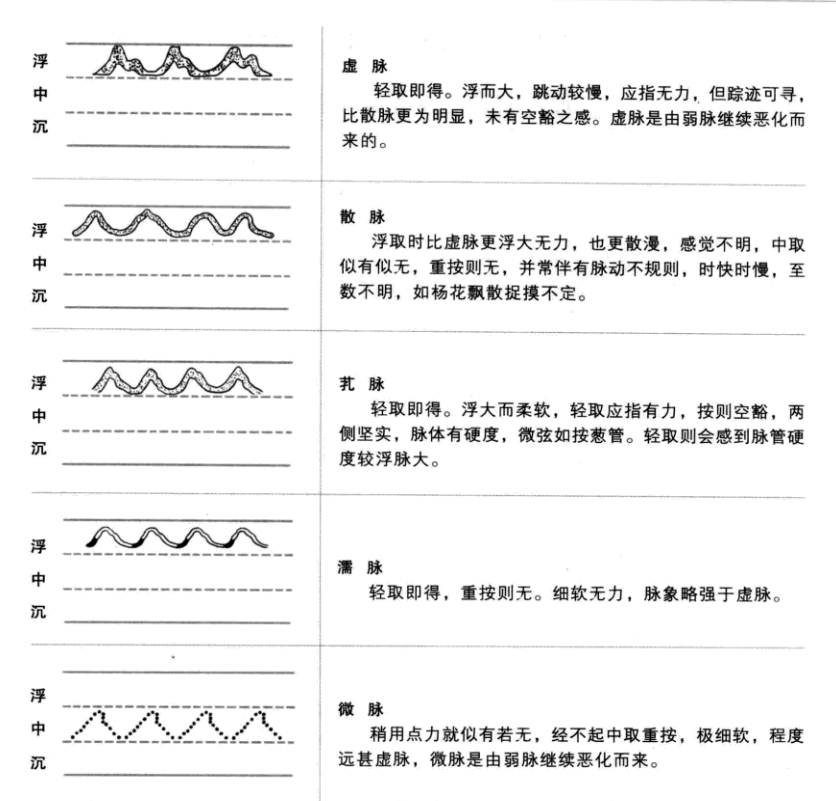 Traditional Chinese Medicine Case Studies / Medical Discussions / Reference Articles for Learning Clinical TCM
Traditional Chinese Medicine Case Studies / Medical Discussions / Reference Articles for Learning Clinical TCM Introduction:How to distinguish between Qiao Mai (Hollow Pulse), Hong Mai (Surging Pulse), Xu Mai (Weak Pulse), Ru Mai (Soft Pulse), San Mai (Scattered Pulse), and Wei Mai (Minute Pulse), which are all types of floating pulses?
Introduction:How to distinguish between Qiao Mai (Hollow Pulse), Hong Mai (Surging Pulse), Xu Mai (Weak Pulse), Ru Mai (Soft Pulse), San Mai (Scattered Pulse), and Wei Mai (Minute Pulse), which are all types of floating pulses?
Floating pulse and its easily confused pulses
Floating Pulse has a pulse quality that resembles the clear yang energy in the sky, lightly rising. When palpating the pulse, one can feel its beating with just a light touch on the skin, akin to wood floating on water, gently surfacing on the body. Pressing harder slightly diminishes the sensation, but it does not feel empty or weak. There are six pulses that are similar to the floating pulse: Hong Mai, Xu Mai, San Mai, Qiao Mai, Ru Mai, and Wei Mai. The pulse is floating and strong, with a large pulse body, coming and going robustly, indicating a long-lasting Hong Mai; the pulse is floating but weak, although the pulse body is larger, it feels soft and slow upon pressing, indicating Xu Mai; the pulse is floating and scattered, feeling unclear, lightly pressing reveals a disordered sensation, moderately pressing feels empty, and heavily pressing yields nothing, accompanied by irregular pulsations that are sometimes fast and sometimes slow but continuous. If it is softer than Xu Mai, and with slight pressure it disperses in all directions, it is called San Mai; if the pulse body is floating and soft, resembling pressing on a scallion stalk, with the middle being empty and the sides being solid, when pressed heavily, the middle yields nothing while the sides remain, it is Qiao Mai; if the pulse body is floating and soft, lightly pressing feels like cotton floating on water, it is Ru Mai; finer and softer than Ru Mai, with slight pressure feeling like it is there and not there, unable to withstand heavy pressing, it is Wei Mai.
Comparison chart of floating pulse and easily confused pulses
Qiao Mai, Hong Mai, Xu Mai, Ru Mai, San Mai, and Wei Mai are all types of floating pulses, and their commonality is that they can all be obtained by floating palpation. Therefore, they should be distinguished more carefully.
 Note: Specific treatments and medications should follow medical advice! This article is excerpted from “Li Shizhen’s Guide to Pulse Diagnosis”, interpreted by Wang Jiran and Zhang Li, Chongqing Publishing House, 2010.2.You May Also Like, click to read the original text:What is the happy pulse in pulse diagnosis? How to identify it?This formula is often used by Elder Feng to treat Sjögren’s syndrome//////////
Note: Specific treatments and medications should follow medical advice! This article is excerpted from “Li Shizhen’s Guide to Pulse Diagnosis”, interpreted by Wang Jiran and Zhang Li, Chongqing Publishing House, 2010.2.You May Also Like, click to read the original text:What is the happy pulse in pulse diagnosis? How to identify it?This formula is often used by Elder Feng to treat Sjögren’s syndrome////////// 【 Read Previous Highlights 】
【 Read Previous Highlights 】


